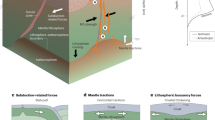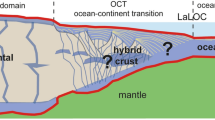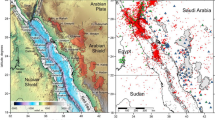Abstract
Oceanic crust is created by the extraction of molten rock from underlying mantle at the seafloor ‘spreading centres’ found between diverging tectonic plates. Modelling studies have suggested that mantle melting can occur through decompression as the mantle flows upwards beneath spreading centres1, but direct observation of this process is difficult beneath the oceans. Continental rifts, however—which are also associated with mantle melt production—are amenable to detailed measurements of their short-term kinematics using geodetic techniques. Here we show that such data can provide evidence for an upwelling mantle flow, as well as information on the dimensions and timescale of mantle melting. For North Island, New Zealand, around ten years of campaign and continuous GPS measurements in the continental rift system known as the Taupo volcanic zone reveal that it is extending at a rate of 6–15 millimetres per year. However, a roughly 70-kilometre-long segment of the rift axis is associated with strong horizontal contraction and rapid subsidence, and is flanked by regions of extension and uplift. These features fit a simple model that involves flexure of an elastic upper crust, which is pulled downwards or pushed upwards along the rift axis by a driving force located at a depth greater than 15 kilometres. We propose that flexure is caused by melt-induced episodic changes in the vertical flow forces that are generated by upwelling mantle beneath the rift axis, triggering a transient lower-crustal flow. A drop in the melt fraction owing to melt extraction raises the mantle flow viscosity and drives subsidence, whereas melt accumulation reduces viscosity and allows uplift—processes that are also likely to occur in oceanic spreading centres.
This is a preview of subscription content, access via your institution
Access options
Access Nature and 54 other Nature Portfolio journals
Get Nature+, our best-value online-access subscription
$29.99 / 30 days
cancel any time
Subscribe to this journal
Receive 51 print issues and online access
$199.00 per year
only $3.90 per issue
Buy this article
- Purchase on Springer Link
- Instant access to full article PDF
Prices may be subject to local taxes which are calculated during checkout




Similar content being viewed by others
References
McKenzie, D. & Bickle, M. J. The volume and composition of melt generated by extension of the lithosphere. J. Petrol. 29, 625–679 (1988)
Wilson, C. J. N . et al. Volcanic and structural evolution of Taupo Volcanic Zone, New Zealand: a review. J. Volcanol. Geotherm. Res. 68, 1–28 (1995)
Beavan, J. et al. New Zealand GPS velocity field: 1995–2013. N. Z. J. Geol. Geophys. 59, 5–14 (2016)
Geonet (Geological Hazard Information for New Zealand). www.geonet.org.nz (2016)
Dimitrova, L. L., Wallace, L. M., Haines, A. J. & Williams, C. A. High-resolution view of active tectonic deformation along the Hikurangi subduction margin and the Taupo Volcanic Zone, New Zealand. N. Z. J. Geol. Geophys. 59, 43–57 (2016)
Hamling, I. J., Hreinsdottir, S. & Fournier, N. The ups and downs of the TVZ: geodetic observations of deformation around the Taupo Volcanic Zone, New Zealand. J. Geophys. Res. Solid Earth 120, 4667–4679 (2015)
Smith, E. G., Williams, T. D. & Darby, D. J. Principal component analysis and modeling of the subsidence of the shoreline of Lake Taupo, New Zealand, 1983–1999: evidence for dewatering of a magmatic intrusion? J. Geophys. Res. Solid Earth 112, G08406 (2007)
Hamling, I. J., Hreinsdóttir, S., Bannister, S. & Palmer, N. Off-axis magmatism along a subaerial back-arc rift: observations from the Taupo Volcanic Zone, New Zealand. Sci. Adv. 2, e1600288 (2016)
Lamb, S. & Smith, E. The nature of the plate interface and driving force of interseismic deformation in the New Zealand plate-boundary zone, revealed by the continuous GPS velocity field. J. Geophys. Res. 118, 3160–3189 (2013)
Walcott, R. I. The kinematics of the plate boundary zone through New Zealand: a comparison of short-and long-term deformations. Geophys. J. Int. 79, 613–633 (1984)
Walcott, R. I. Geodetic strain and the deformational history of the North Island of New Zealand during the late Cainozoic. Phil. Trans. R. Soc. A 321, 163–181 (1987)
Wallace, L. M., Beavan, J., McCaffrey, R. & Darby, D. Subduction zone coupling and tectonic block rotations in the North Island, New Zealand. J. Geophys. Res. 109, B12406 (2004)
GNS Science Active Fault Database. https://data.gns.cri.nz (2016)
Okada, Y. Surface deformation due to shear and tensile faults in a half-space. Bull. Seismol. Soc. Am. 75, 1135–1154 (1995)
Watts, A. B. Isostasy and Flexure of the Lithosphere (Cambridge Univ. Press, 2001)
Bannister, S., Bourguignon, S., Sherburn, S. & Bertrand, E. A. 3-D seismic velocity and attenuation in the central Taupo Volcanic Zone, New Zealand: imaging the roots of geothermal systems. In Proc. World Geothermal Congr. (Melbourne, April 2015) 19–25 (International Geothermal Association, 2015)
Bertrand, E. A. et al. Magnetotelluric imaging of upper-crustal convection plumes beneath the Taupo Volcanic Zone, New Zealand. Geophys. Res. Lett. 39, L02304 (2012)
Bibby, H. M., Caldwell, T. G., Davey, F. J. & Webb, T. H. Geophysical evidence on the structure of the Taupo Volcanic Zone and its hydrothermal circulation. J. Volcanol. Geotherm. Res. 68, 29–58 (1995)
Heise, W., Caldwell, T. G., Bibby, H. M. & Bennie, S. L. Three-dimensional electrical resistivity image of magma beneath an active continental rift, Taupo Volcanic Zone, New Zealand. Geophys. Res. Lett. 37, L10301 (2010)
Heise, W. et al. Imaging the deep source of the Rotorua and Waimangu geothermal fields, Taupo Volcanic Zone, New Zealand. J. Volcanol. Geotherm. Res. 314, 39–48 (2016)
Stern, T. A. Asymmetric back-arc spreading, heat flux and structure associated with the Central Volcanic Region of New Zealand. Earth Planet. Sci. Lett. 85, 265–276 (1987)
Stern, T. & Benson, A. Wide-angle seismic imaging beneath an andesitic arc: Central North Island, New Zealand. J. Geophys. Res. 116, B09308 (2011)
Chen, Y. & Morgan, W. J. Rift valley/no rift valley transition at mid-ocean ridges. J. Geophys. Res. 95, 17571–17581 (1990)
Phipps Morgan, J., Parmentier, E. M. & Lin, J. Mechanisms for the origin of mid-ocean ridge axial topography: implications for the thermal and mechanical structure of accreting plate boundaries. J. Geophys. Res. 92, 12823–12836 (1987)
Scott, D. R. & Stevenson, D. J. A self-consistent model of melting, magma migration and buoyancy-driven circulation beneath mid-ocean ridges. J. Geophys. Res. 94, 2973–2988 (1989)
Turcotte, D. L. & Schubert, G. Geodynamics: Applications of Continuum Physics to Geological Problems (John Wiley, 1982)
Ranalli, G. Rheology of the Earth (Springer, 1995)
Hirth, G. & Kohlstedt, D. in Inside the Subduction Factory (ed. Eiler, J. ) 83–105 (Wiley, 2003)
ten Brink, U. Volcano spacing and rigidity. Geology 19, 397–400 (1991)
Altamimi, Z., Métivier, L. & Collilieux, X. ITRF2008 plate motion model. J. Geophys. Res. 117, B07402 (2012)
Lamb, S. Kinematics to dynamics in the New Zealand plate boundary zone: implications for the strength of the lithosphere. Geophys. J. Int. 201, 552–573 (2015)
Wessel, P., Smith, W. H. F., Scharroo, R., Luis, J. F. & Wobbe, F. Generic Mapping Tools: improved version released. Trans. AGU 94, 409–410 (2013)
Stern, T.A., Quinlan, G.M. & Holt, W.E., Basin formation behind an active subduction zone: three-dimensional flexural modelling of the Wanganui Basin, New Zealand. Basin Res. 4, 197–214 (1992)
Spiegelman, M. & McKenzie, D. Simple 2-D models for melt extraction at mid-ocean ridges and island arcs. Earth Planet. Sci. Lett. 83, 137–152 (1987)
Ribe, N. M. On the dynamics of mid-ocean ridges. J. Geophys. Res. 93, 429–436 (1988)
Crameri, F. et al. A comparison of numerical surface topography calculations in geodynamic modelling: an evaluation of the ‘sticky air’ method. Geophys. J. Int. 189, 38–54 (2012)
Acknowledgements
This paper is part of a wider project funded through the New Zealand Marsden Fund, the Earthquake Commission, and Victoria University of Wellington graduate scholarships. J.D.P.M. was supported by the National Research Foundation of Singapore (award NRF-NRFF2013-04) at the Earth Observatory of Singapore.
Author information
Authors and Affiliations
Contributions
S.L. led the research, carried out the kinematic and flexural analysis, developed the mantle force model and wrote the manuscript. J.D.P.M. developed the viscous flow finite-element models. E.S. calculated horizontal and vertical continuous GPS velocities and their uncertainties. T.S. provided advice and help with all aspects of the study. All authors commented on the manuscript.
Corresponding author
Ethics declarations
Competing interests
The authors declare no competing financial interests.
Additional information
Reviewer Information Nature thanks C. Beaumont, E. Calais and C. Faccenna for their contribution to the peer review of this work.
Publisher's note: Springer Nature remains neutral with regard to jurisdictional claims in published maps and institutional affiliations.
Extended data figures and tables
Extended Data Figure 1 GPS-derived horizontal velocities.
These horizontal velocities are based on 16 years of campaign3 and up to 10 years of continuous4 GPS velocities (black arrows, and with 1σ indicated by ovals; see Methods) in the TVZ, for the area outlined in grey in Fig. 1. The figure also shows the Delauney triangulation networks (blue) used to calculate the strain-rate field, and the swath of velocity projection into profile AA′ (see Figs 2 and 3).
Extended Data Figure 2 GPS-derived strain rates and vertical velocities.
a, b, Contours show subsidence rate and coloured areas show dilatation, calculated from GPS-based horizontal velocities for campaign (a) and continuous (b) data (see Methods). Black circles show the locations of GPS sites. Horizontal velocities are obtained from campaign GPS data for the period 1995 to 2011 (refs 3, 4); vertical velocities from campaign GPS data cover the period 2005 to 2014 (ref. 6). Continuous GPS data cover 3–15-year timespans (see ref. 4 and Methods). Thick solid red lines show lines of profiles AA′ (swath shown by dashed red rectangle) and BB′ modelled in this study (see Figs 2 and 3). c, Principal axes of strain rate plotted on the field of dilatation calculated from combined campaign and continuous GPS data (see Fig. 2 and Methods).
Extended Data Figure 3 Elastic dislocation models of normal faulting.
a, b, Elastic half-space dislocation models of interseismic strain accumulation for slip on a buried normal fault in the TVZ, using the twist-up method9 (which satisfies the far-field vertical velocity boundary condition with no relative vertical motion between the fore arc and the Australian plate). Models are two-dimensional, fitted along profile AA′ in Fig. 2, using the horizontal velocity resolved parallel to the profile. Models with one or two faults result in the greatest perturbation of velocities from a simple linear slope, but still provide only poor fits, especially to the observed horizontal velocities in the vicinity of the rift axis. Open black diamonds denote observed horizontal velocities with 1σ error bars resolved along the line of profile; open circles denote observed vertical velocities with 1σ error bars; lines of red and blue crosses denote model horizontal and vertical velocities, respectively. a, A single fault, dipping by 45° at the surface and merging with a listric decollement at depth, accommodating extension at 11 mm per year. The average misfit (see Methods) between the model and observations is 2.4 mm per year for all velocities, and 2.7 mm per year for just horizontal velocities. b, Two antithetic faults, each accommodating extension at 5.5 mm per year and dipping at 45° into the rift zone, merging with a listric decollement at depth. The average misfit between the model and observations is 3.3 mm per year for all velocities, and 3.6 mm per year for just horizontal velocities.
Extended Data Figure 4 Calculating flexural strain rates and viscous flow forces.
a, Diagram illustrating how velocities and strain rates are calculated for a simple model of downward flexure of a continuous elastic plate, pulled down by an axial load. The shape of flexure is determined by the thickness (Te) of the elastic core, whereas the strain rate and velocities are determined by the half-beam thickness, where elastic flexure has occurred but the flexural stresses in the upper and lower portions of the beam have exceeded the yield strength (see also Methods and ref. 15). b, Resultant velocities, Vtot, in models are obtained by adding the velocity solution for flexural models, Vflex, to a linear increase in velocity across the TVZ to account for far-field tectonic extension Vext (see Methods). c, Diagram illustrating the geometry of a flexed elastic plate (with a brittle upper crust), overlying a viscous lower crust (of viscosity ηcrust) with effective thickness Tv, pulled down at velocity Vvertical by a basal normal traction, σn, over a characteristic width W above an upwelling mantle flow at velocity Vext (viscosity ηmantle). In this case, σn ≈ 2ηVext/W.
Extended Data Figure 5 Flexure and strain rates in a three-dimensional elastic plate.
Modelled flexure of a roughly 11-km-thick continuous plate floating on an inviscid fluid, with the plate having a 2.75-km-thick elastic core, pulled down at a rate of 13 mm per year by an axial load 8 km wide and 60 km long. (The load extends in the x direction for plus/minus the half-width, and in the y direction for plus/minus the half-length.) The horizontal dimensions of the plate are very large compared with the dimensions of the load (the size of the horizontal plate in this calculation was 400 km by 400 km), so edge effects are negligible. a, Dilatation and vertical motion (in mm per year) of the plate. b, Dilatation and vertical motion (in mm per year) of the plate with far-field extensional strains added (see Methods), with a dilatation gradient in the y direction (illustrated here for x = ±50 km) of 0.5 × 10−7 per year at y = −80 km to 1.2 × 10−7 per year at y = +80 km.
Extended Data Figure 6 Subsidence resulting from a source of compaction in elastic half-space.
a, b, Elastic half-space model for surface distortion from a buried compacting horizontal planar source (15 km wide by 60 km long) at a depth of 17 km, using the Okada formulation for contractional dislocations14 that are orthogonal to a horizontal rectangle, for resolved horizontal velocities along profile AA′. The average misfit between the model and observations is 1.6 mm per year for all velocities, and 1.5 mm per year for just the horizontal velocities. The rectangle in panel a shows the horizontal extent of the compacting source. c, Velocities in a vertical plane of the elastic layer above a compacting source. Note that this flow pattern is similar to the flow in a Newtonian viscous half-space with uniform density and viscosity, and no surface topography, responding to internal planar normal traction (see Extended Data Fig. 7).
Extended Data Figure 7 Strain rates and geothermal activity in the TVZ.
Map of the TVZ, showing the pattern of horizontal dilatation found herein, together with the major Pleistocene and Holocene volcanic complexes and caldera2, geothermal systems (from which the total heat loss is about 4.3 GW over 6,000 km2; ref. 18), and low-resistivity patches at 13 km depth (5 Ωm contour), determined from magnetotelluric probing19. There is a broad coincidence between the axis of horizontal contraction and the zone of volcanic activity from the past one million years, but not between this axis and the main geothermal systems, which are offset by 10–15 km to the southeast. The surface expressions of the major geothermal systems seem to be more closely associated with the flanks of the contracting and subsiding zone than with the axis. A similar lack of correlation is seen between the axis of horizontal contraction and the low-resistivity patches (which may reflect deep crustal partial melts or fluid-rich zones19).
Extended Data Figure 8 Finite-element models of instantaneous Newtonian viscous flow in a layer with a basal patch of normal traction (σn).
a–c, The viscous flow field is calculated for three width-to-depth ratios, W/Tv, of the basal patch. The surface is flat, and viscosity is scaled with velocity V, using the scaling Vη/(σnTv). Each upper panel shows stream lines of flow, and each bottom panel shows flow velocities. a, W/Tv = 0.5. b, W/Tv = 1. c, W/Tv = 2. See Methods for more details.
Extended Data Figure 9 Scaling relations for viscous flow models.
a, Scaling relations for the viscous flow models of Extended Data Fig. 8, using the maximum surface vertical velocity (Vvertical), the lower-crustal viscosity (ηcrust), the basal normal traction (σn), and the width-to-depth ratio (W/Tv) of the basal patch. The results are shown by plotting Vverticalηcrust/(σnTv) against W/Tv for model runs. For W/Tv ratios greater than 2, Vverticalηcrust/σnTv ≈ W/Tv. b, Ratio of the ‘change’ in mantle viscosity, Δηmantle, to the crustal viscosity, ηcrust, normalized according to the ratio of the velocity of rift extension (Vext) to the maximum vertical velocity (Vvertical). c, Normalized plots illustrating the exponential decay with time (t) of the surface subsidence/uplift rate and the subsidence/uplift in transient lower-crustal viscous flow, for the decay constant (t) and the maximum initial vertical velocity (Vmax). Decay is driven by the evolution of flexural forces in the elastic layer and the gravitational potential energy in the underlying viscous flow after a perturbation in a driving basal force (Extended Data Fig. 8). See Methods for more details.
Rights and permissions
About this article
Cite this article
Lamb, S., Moore, J., Smith, E. et al. Episodic kinematics in continental rifts modulated by changes in mantle melt fraction. Nature 547, 84–88 (2017). https://doi.org/10.1038/nature22962
Received:
Accepted:
Published:
Issue Date:
DOI: https://doi.org/10.1038/nature22962
Comments
By submitting a comment you agree to abide by our Terms and Community Guidelines. If you find something abusive or that does not comply with our terms or guidelines please flag it as inappropriate.



